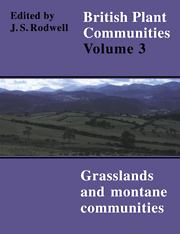Book contents
- Frontmatter
- Contents
- List of Figures
- Preface and Acknowledgements
- Preamble
- Mesotrophic Grasslands
- Community Descriptions
- Calcicolous Grasslands
- Community Descriptions
- Calcifugous Grasslands and Montane Communities
- Community Descriptions
- Index of Synonyms to Grasslands and Montane Communities
- Index of Species in Grasslands and Montane Communities
- Bibliography
MG1 - Arrhenatherum Elatius Grassland Arrhenatheretum Elatioris Br.-Bl. 1919
Published online by Cambridge University Press: 04 July 2020
- Frontmatter
- Contents
- List of Figures
- Preface and Acknowledgements
- Preamble
- Mesotrophic Grasslands
- Community Descriptions
- Calcicolous Grasslands
- Community Descriptions
- Calcifugous Grasslands and Montane Communities
- Community Descriptions
- Index of Synonyms to Grasslands and Montane Communities
- Index of Species in Grasslands and Montane Communities
- Bibliography
Summary
Synonymy
Arrhenatheretum elatioris sub-atlanticum R.Tx. (1937) 1955; Arrhenatherum elatius stands Pfitzenmeyer 1962 p.p.; Pastinaco-Arrhenatheretum (Knapp 1954) Passarge 1964; Centaureo-Arrhenatheretum O’Sullivan 1965; Slope grassland Packham et al. 1966, 1967; Arrhenatheretum elatioris inops Neijenhuijs & Westhoff 1968; Tall herb community Lloyd 1968; Speciesrich Arrhenatherum grassland Lloyd 1972 p.p.; Arrhenatherum elatius! Festuca rubra! Helictotrichon pubescens grassland Wells et al. 1976.
Constant species
Arrhenatherum elatius, Dactylis glomerata.
Rare species
Silene nutans.
Physiognomy
The Arrhenatheretum elatioris is a community in which coarse-leaved tussock grasses, notably Arrhenatherum elatius with usually smaller amounts of Dactylis glomerata and Holcus lanatus, are always conspicuous and generally dominant. Large umbellifers are frequent throughout and sometimes abundant and the sequential flowering of first, Anthriscus sylvestris and later, Heracleum sphondylium and Chaerophyllum temulentum, can give stands a distinctive creamy-white haze throughout most of late spring and summer. Apart from Cirsium arvense, Centaurea nigra and Urtica dioica, other tall herbs are generally infrequent, though a variety of species may attain dominance locally (see variants below).
Beneath these taller species there is usually a layer of fine-leaved grasses, most frequently Festuca rubra, Poa pratensis, P. trivialis, Lolium perenne and Elymus repens, and small dicotyledons, notably Trifolium pratense, T. repens, Achillea millefolium, Taraxacum officinale agg., Plantago lanceolata, Lotus corniculatus and Rumex acetosa. At the height of the growing season the vegetation often becomes choked by sprawling legumes such as Lathyrus pratensis, Vicia sativa ssp. nigra ( = V. angustifolia L. = V. sativa ssp. angustifolia (L.) Gaud.), V. cracca and V. sepium and trailing stems of Galium aparine and Rubus fruticosus agg. Certain species, for example Taraxacum officinale agg. and occasional characteristic of woodlands like Ranunculus ficaria and Mercurialis perennis, complete most of their growth and flower before this substantial bulk of vegetation has developed.
There is often a large amount of standing dead material in winter in the Arrhenatheretum and some ground litter generally persists throughout the year. Bryophytes are usually confined to thin wefts of pleurocarpous mosses over this decaying vegetation and on sparse patches of bare soil. Brachythecium rutabulum is the most frequent species throughout with some Eurhynchium praelongum, Pseudoscleropodium purum and Rhytidiadelphus squarrosus.
- Type
- Chapter
- Information
- British Plant Communities , pp. 32 - 42Publisher: Cambridge University PressPrint publication year: 1992

